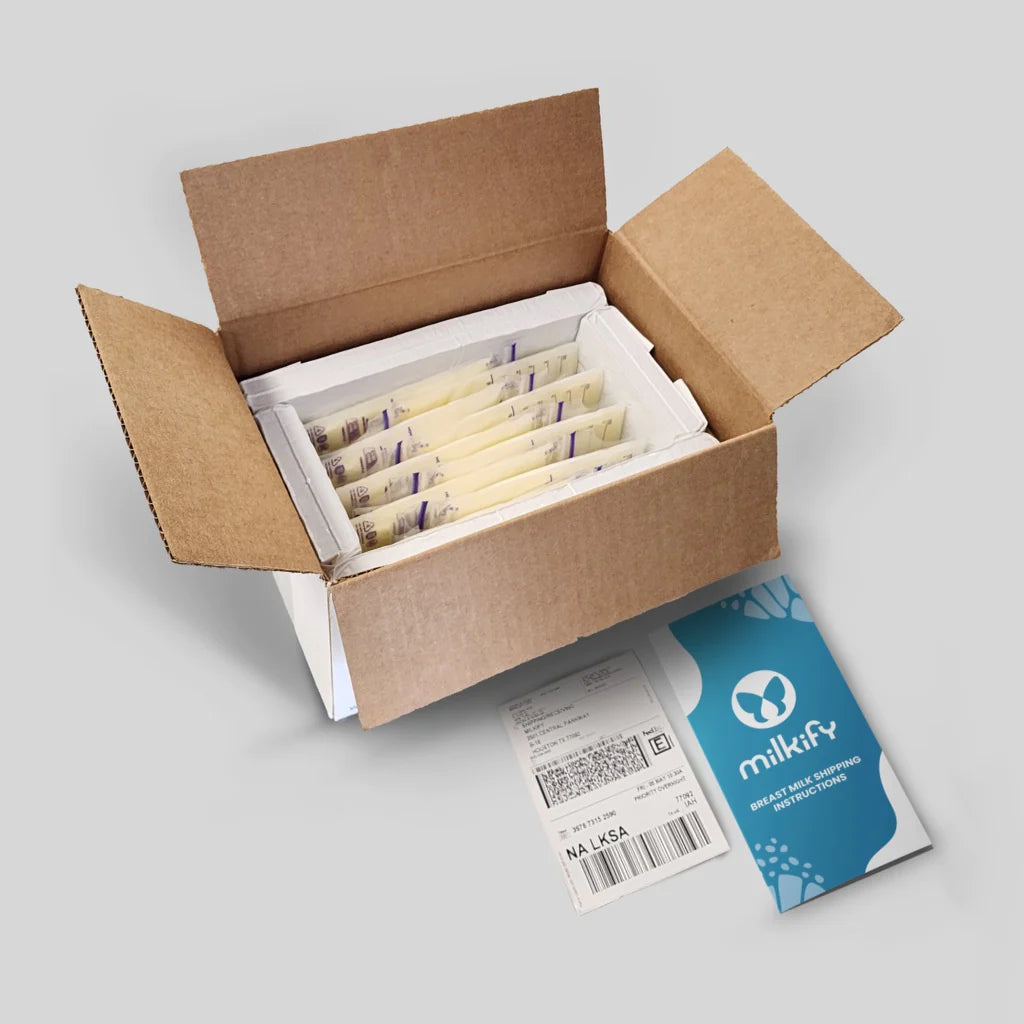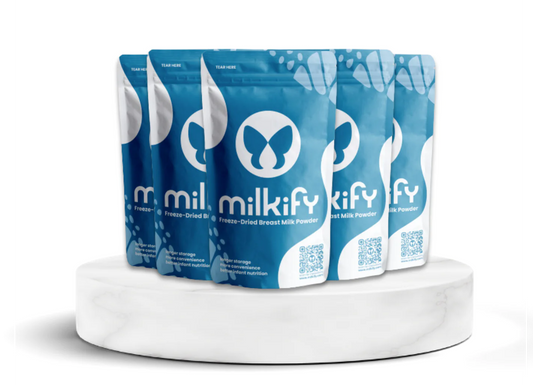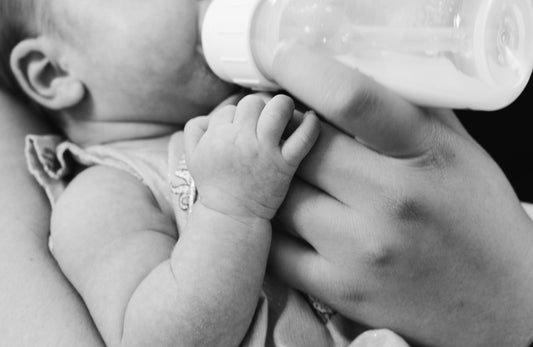For working mothers, military personnel, mothers of premature babies, or any breastfeeding mother who finds herself away from her child, shipping breast milk long distances is sometimes a necessity rather than a luxury.
Because breast milk can quickly spoil if not kept at the correct temperature, shipping breast milk requires careful planning and execution to ensure that the milk reaches its destination without compromising its nutritional quality, safety, and integrity.
Preparation: Storing and Freezing Breast Milk Effectively
Correct Storage
The first step in shipping breast milk involves correctly storing and freezing the milk. If possible, freeze the milk in small quantities, between three and five ounces per bag. This allows the milk to freeze quickly and thoroughly, reducing the likelihood of bacterial growth.
Freezing your milk in smaller quantities is especially key if you are pumping while traveling. This is because you will be limited on time, and hotel freezers can be hit-or-miss in their freezing capacity. Whether you are shipping your milk to Milkify or directly to your home at the end of your trip, it’s best that your milk be fully frozen when you ship. This will keep your milk safe for longer, which buys you time in case of shipping delays.
High-Quality Bags
Invest in high-quality breast milk storage bags specifically designed for freezing. Ensure they're durable, leak-proof, and BPA-free, as these bags are made to withstand freezing temperatures and protect the milk from potential contaminants.
The brand of bags you choose will also affect how tightly you will be able to pack your milk in your shipping cooler. Some brands, like Lansinoh, have a compact design and are easy to pack efficiently. For efficient packing, avoid brands whose design have extra plastic on the sides, unusual shapes, or extra features like bottle caps.
The more tightly packed your milk is, the longer it will remain frozen in your shipping cooler. Being able to tightly pack your milk in the cooler also makes it less likely that you’ll run out of space when it comes time to ship.
Lay Bags Flat
When freezing the milk, lay the bags flat in the freezer. This technique ensures the milk freezes uniformly and quickly. Plus, the flat shape makes the bags easy to pack, maximizing storage space, and making packing a much easier process.
Again, this is especially important if you are pumping while traveling. Avoid having to play complex games of “Tetris” with your frozen milk when you’ve got a flight to catch!
For bonus points, using a product like the Milkies Freeze can help ensure your bags are frozen flat, every time. We also like the “first in, first out” storage method this product provides.
The Packing Process: Prioritizing Insulation and Protection
Insulated Shipping Box
Packaging the frozen breast milk correctly is key to its safe arrival. For this, you need a well-insulated shipping box that can handle a potentially bumpy ride in transit without collapsing or cracking.
Traditionally, styrofoam coolers have been the top choice for moms who need to ship their breast milk. We recommend the Polar Tech brand, which you can buy on Amazon. But there are downsides to styrofoam coolers:
- Styrofoam is a relatively cheap form of insulation, and styrofoam by itself won’t keep your milk frozen for more than a day (at most); you’ll need to use ice packs or dry ice (more on this below)
- Styrofoam can break during an especially rough ride, leading to loss of insulation; you’ll want to use a heavy duty cardboard shipping box along with packing materials like bubble wrap to protect the cooler
- If you are traveling, you’ll have to plan to bring the cooler with you or have it shipped to your destination – in addition to your suitcase, breast pump, and all the extra parts, this is one more thing to worry about!
A better alternative to styrofoam coolers is a medical-grade NanoCool insulated shipper like the ones we use at Milkify. The vacuum sealed insulation is much better than styrofoam and will keep your milk frozen for up to 4 days without any ice packs or dry ice.
The downside to buying one of these NanoCools yourself is that they are expensive. But when you ship with Milkify, a NanoCool shipping kit is always included in the price. We reuse our coolers (after thoroughly cleaning and sanitizing them between uses), so there is no cost to using them.
Side note: the cost of Priority Overnight shipping within the continental U.S. is always included with your Milkify shipping kit – and we pass our FedEx discounts on to you. We can even ship a shipping kit to your hotel destination and help coordinate FedEx pick-ups, making shipping as easy as possible. If you need this service, just give us a call or send us an email.
When you ship your milk to Milkify, we can ship your freeze-dried breast milk powder anywhere in the world, including to your home or to your new address. This includes military bases and military or diplomatic post offices around the world. Again, all shipping within the continental U.S. is always included in the price of your Milkify shipping kit.
Gel Ice Packs
If you do ship with a styrofoam cooler, plan to use ice packs. The best brand we’ve found is Cooler Shock, which you can get on Amazon. These gel packs work almost as well as dry ice.
If you go the dry ice route, be sure to handle it safely. You’ll want to use gloves or a towel to avoid a dry ice burn. While dry ice is relatively inexpensive and can be purchased at most grocery stores, it’s considered a hazardous material and will require special labeling when shipped. Not all FedEx and UPS stores will accept dry ice shipments, so you’ll want to check with the local store you plan to ship from for any specific requirements.
You’ll also want to take care to give the lid of your cooler room to breathe, so that gas can escape. This means you should never tape the lid of your cooler if using dry ice. Dry ice does not melt - it sublimates* (changes from solid to gas). If there is no place for the air to go, pressure will build up inside your cooler, which can cause it to pop or “explode” during transit.
Whether you use ice packs or dry ice, you’ll want to place your frozen breast milk at the bottom of the cooler. If you are only shipping a small quantity of milk, you can also “sandwich” your milk in between two layers of ice packs. As a general rule of thumb, the frozen materials on top and on the sides will be the first to thaw, while the middle and bottom of your cooler will stay frozen the longest.
If you use the NanoCool insulated shippers, you won’t need any dry ice or ice packs as long as you are able to fill the entire cooler with frozen milk. If there is a significant amount of empty room in your cooler, you can place ice packs on top of your milk. This will help the cooler keep your milk frozen for longer.
If you are traveling and don’t have access to ice packs near your hotel, you can take a clean plastic trash bag from your room and fill it with ice from the ice machine. Voila, you’ve got yourself a MacGyver ice pack!
* Side note / fun fact: the principle of sublimation (when ice goes from solid to gas, skipping the thawing/melting phase) is the same driving force behind freeze-drying breast milk! In a frozen vacuum chamber, the frozen water in your breast milk behaves just like dry ice does at room temperature. The water in your milk turns into a gas and escapes your milk, leaving the solids (like the nutrients, vitamins, and antibodies) behind as a fluffy white powder.
Fill the Gaps
If there are any gaps or spaces left in the box after packing, fill them with bubble wrap, foam peanuts, or crumpled newspaper. If you are a hotel, ask the front desk for old magazines or newspapers. These materials provide a little bit of additional insulation, but more importantly they prevent the milk from jostling around and serve to protect the integrity of your cooler while in transit.
Note: these packing materials are always included in every Milkify breast milk shipping kit.
The Importance of Clear Labeling
Accurate and clear labeling of your package can help ensure it is handled appropriately during transit. Mark the box with labels like “Contains Breast Milk”, "Perishable," "Keep Refrigerated," "Fragile," or "Handle with Care."
FedEx and UPS workers are human beings. We interact with a lot of them here at Milkify, and we’ve known them to take pride in their work. These markings convey to all handlers that the contents need special attention, increasing the chance of your package receiving the care it requires.
Shipping Service: Making an Informed Choice
Choosing the right shipping service is a significant part of the process. Opt for a service that offers overnight shipping to minimize the time your milk spends in transit. The less time your package spends in transit, the higher the likelihood of your milk staying frozen. In the U.S., we like FedEx and UPS for frozen shipments of breast milk. For international shipments, we like DHL as a fast and reliable option.
Avoid shipping later in the week, as the chances of your package sitting idle over the weekend increase. This idle time can affect the package's internal temperature, risking the quality of the milk. If sending your milk to Milkify, we recommend shipping on Monday, Tuesday, or Wednesday whenever possible. Shipments from Hawaii or Alaska to Milkify should be sent on Monday or Tuesday if possible. If absolutely necessary, you can ship on other days of the week, but we may need to make special arrangements. Contact us to discuss the specifics of your situation, and we’ll work with you to find the best solution.
If you are shipping your breast milk to a residential address, it may be possible to arrange for Saturday Delivery of an Express package. This comes with an additional cost and is not available in all areas, so check with your FedEx or UPS store ahead of time.
Should You Ship Breast Milk with Signature Confirmation?
Signature Confirmation is a service offered by FedEx and UPS. It means the driver will only release the package if someone is physically present at the destination to sign for your package.
This can be beneficial if you are shipping your milk to a residence that is prone to porch pirates / package theft, or to an apartment complex where packages often get “lost” or misplaced. Signature confirmation will prevent your package from being left on a porch or common area.
There is a significant downside to signature confirmation: if no one is available to sign for the package, it will go back on the delivery truck. FedEx or UPS will typically attempt to re-deliver it the next day. This extra 24 hours can be the difference between your milk arriving frozen, or thawing in transit.
If this happens to you, we recommend immediately getting in touch with your carrier by calling their support number. You can usually get your package rerouted to a local FedEx or UPS store where you’ll be able to pick it up that same day. A few hours can make all the difference when shipping frozen breast milk, but you’ll need to call them early enough in the day. This is why it’s important to keep your eye on your email for shipping notifications anytime your breast milk is in transit.
Checking Temperature at Arrival: The Final Step in the Process
Once your breast milk is delivered, the recipient should immediately open the cooler and inspect the bags to make sure they were frozen the entire time. If some thawing occurred, check the bags for ice crystals. If these are present, the milk is still likely safe for consumption. If any bags thawed completely, you should consider these as not safe for consumption. Clearly mark these bags as such with a sharpie – they can still be used for milk baths, just not for feedings.
Shipping breast milk long distances might seem like an intimidating process. Some moms have even told us that shipping their breast milk feels as daunting as shipping their baby! However, with careful planning, the right tools, and a good understanding of the process, you can successfully deliver this liquid gold to your little one, no matter the distance.






